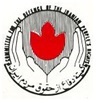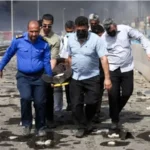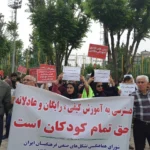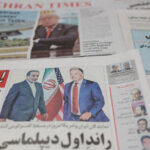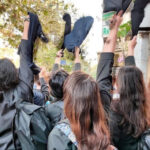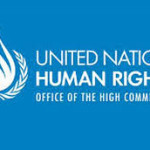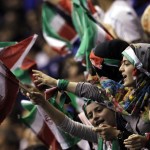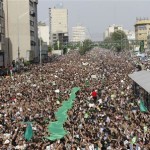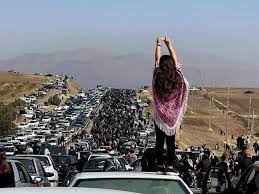
21 September 2023
The anniversary of the murder in custody of 22 year old Mahsa Amini, by the Iranian regime saw the theocratic dictatorship tighten security in an attempt to suppress protests to mark the anniversary. Steve Bishop reports.
On 16 September 2022 Mahsa Amini was detained by the Iranian regime’s morality police for allegedly breaking the rules on what the regime deems to be appropriate dress for women.
Security forces claim that Ms. Amini suddenly collapsed from a heart attack at the detention centre, while receiving educational training on hijab rules. This claim is disputed by Ms Amini’s family, who say that she was perfectly healthy before her arrest.
The grip of the theocratic dictatorship, which has been in place in Iran since the early 1980’s has been tested over the past year, following the death in custody of Ms Amini.
In particular, Ms Amini’s death has tapped into a deep well of resentment felt by the women of Iran, who are increasingly frustrated by the restrictions imposed upon their economic and social activity by the regime, and the lack of protection from domestic abuse. The Woman, Life, Freedom movement which has emerged since Amini’s murder has been one component in a widespread series of strikes and protest actions, involving workers, farmers, teachers, pensioners, nurses and students.
A recent Fact Finding Mission, mandated by the United Nations Human Rights Council indicated that Mahsa Amini’s father and uncle were arrested by security forces, in the days leading up to the anniversary, in their hometown Saqqez. Their whereabouts “remain unknown”.
The grave of Mahsa Amini was also reportedly desecrated, and family members prevented from mourning. The family’s lawyer and journalists covering her case have also been harassed.
CODIR has consistently campaigned for an independent inquiry into the death of Ms Amini and raised the issue through its delegation at the recent TUC conference.
The crackdown in October 2022, against protests following the death of Ms Amini, saw 500 killed at the hands of the regime and over 20,000 arrested. As the anniversary approached, the regime’s morality police stepped up their activities, to coincide with the dictatorship’s announcement of a fresh campaign to compel women to wear the hijab.
The draft law sets out a range of proposals, including “much longer prison terms for women who refuse to wear the veil, stiff new penalties for celebrities and businesses who flout the rules, and the use of artificial intelligence to identify women in breach of the dress code”.
Under the current “hijab law”, a breach of the dress code is punishable by 10 days to two months imprisonment, or a fine ranging from 50,000 to 500,000 Iranian rials ($1.18 to $11.82).
The new bill would reclassify failure to wear the hijab as a more severe offence, punishable by a five-to-ten-year prison sentence as well as a higher fine of up to 360 million Iranian rials ($8,508). Given that the average salary in Iran is currently equivalent to $460 per month such a fine is clearly far beyond the affordability of an average Iranian.
The regime’s crackdown in advance of the anniversary, has seen nearly 200 executions reported in the first half of this year alone. Executions have been based upon charges such as “insulting the prophet“, “blasphemy”, “insulting the prophet’s mother” and “belittling the Quran.”
While Iranians continue to struggle due to the mismanagement of the economy, endemic corruption within the ruling clergy and the ongoing sanctions faced by the regime, hardline President Ebrahim Raisi has allocated $3.8 million to the so called, Initiative for Promotion of Virtue and Prevention of Vice, in order to increase the surveillance of female employees at government agencies.
Raisi has also issued a clear warning to Iranian women that the hijab law will be enforced and claimed, in a recent speech, that women opposing the hijab were a “minority being trained by foreigners” with the objective of undermining the Iranian government.
The focus of the Iranian government upon the issue of ‘hijab removal’ is widely seen as an attempt by the regime to deflect attention away from the ongoing crisis which continues to grip Iran. While the focus of international media has been upon women protesting the hijab laws general discontent amongst the working class, youth and students has been reflected in an ongoing wave of industrial disputes which have hit key sectors of the economy as well as the public sector.
In the last year alone, there were around 1200 sustained workers strikes across the country. There were popular uprisings in late 2017 going into early 2018 and then again in November 2019, which had the people’s material and economic demands at their centre.
Most recently pensioners have been publicly protesting about the shortfall in pension payments and government mismanagement of pension funds. Even official government reports indicate that 17 out of the 18 pension funds in Iran are either bankrupt or teetering on the very brink of becoming so. In addition, a recent report from the Islamic Republic’s Labour Ministry revealed a huge increase in the rate of poverty in Iran, rising by 50 percent in 2021 compared to the year before.
CODIR condemns the regime’s ongoing efforts to create a climate of fear, through the ongoing arrest of civil rights activists, in an attempt to suppress participation in protests.
The US, Britain and the EU, have announced multiple rounds of sanctions against Iran, to mark the death of Ms Amini and the widespread crackdown against protests which have followed. However, the Iranian regime continues to negotiate behind the scenes to normalise relations with the United States and the EU with the Kingdom of Oman acting as a mediator.
While these discussions have not resulted in an outcome to date they underline the desperate need for the Iranian regime to ease sanctions to save the economy from spiralling downwards even faster. For the West the prize would not only be the opening up of the potentially lucrative Iranian market but also a cessation of the Islamic Republic’s support for Russia’s military intervention in Ukraine.
Certainly, the current protest movement in Iran has gone beyond the desire for cosmetic reforms and is increasingly demanding a root and branch overhaul of the Islamic Republic, in favour of a secular national democratic government.
However, while Iran is lauded in some quarters as an anti-imperialist bulwark the theocratic dictatorship will do anything to save its own skin. If that means a deal with the US to constrain the popular protest movement, then a deal may well be done.
It is becoming evident daily that the Iranian regime cannot resolve the deepening socio-economic crises it faces nor its own crisis of legitimacy and is clearly in danger of collapse. Unless foreign interference is engineered to thwart it, that will open the way for the Iranian people to establish a national democratic government. International solidarity with the Iranian people, in their resistance to the theocratic dictatorship, remains a crucial element in their struggle for that opportunity.
CODIR will continue its ongoing campaign for the release of all political prisoners, including those arrested as part of the Woman, Life, Freedom movement.


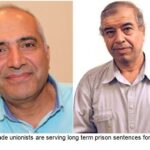
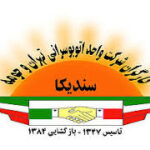


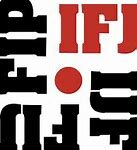




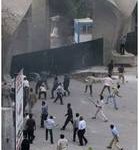
 Posted in
Posted in 